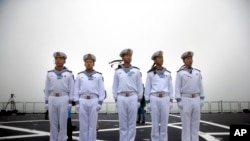A Chinese military vessel is touring the contested South China Sea and beyond to meet foreign peers and train its own sailors, spreading goodwill while tightening its claim to a disputed sea and disrupting Australia’s traditional sphere of influence.
Beijing has upset a swathe of Asia since 2010 by landfilling small islets in the contested South China Sea for military use. Brunei, Malaysia, Taiwan, Vietnam and the Philippines all overlap China's claim to the 3.5 million-square-kilometer waterway. China calls about 90% of the sea its own.
The naval training ship Qi Jiguang set out in late September on a two-month tour for training and visits to foreign countries, the Chinese People’s Liberation Army’s China Military news service says. Brunei, East Timor, Fiji, New Zealand and Papua New Guinea were on the map for the ship’s training-and-visit mission, its second since being commissioned in 2017.
“This is an unusual case as far as I can see,” said Andrew Yang, secretary-general of the Chinese Council of Advanced Policy Studies in Taiwan “I think (China) is probably exercising its soft power, particularly to try to convince the region that China is a benign power, it’s not an antagonistic power.”
A goodwill mission could relieve international pressure on China from as far away as Washington to tone down its maritime expansion.
Beijing began trying in 2016 to improve relations with the other South China Sea claimants after it lost a world arbitration court ruling to the Philippines over sovereignty boundaries. At the same time, Beijing has added military capacity to islets it already controls while exploring oceans normally dominated by Western-allied former Cold War rivals.
Visit to Brunei
The naval training ship called first for three days from September 27 at Port of Muara in Brunei, the Chinese military news service reported. More than 300 people including representatives of the Royal Brunei Navy showed up for its arrival.
Chinese naval sailors and cadets were scheduled to visit a patrol ship under the host navy, hold “professional” exchanges and contribute to a beach environmental protection activity with Bruneian navy sailors, the news service said.
Brunei and China dispute sovereignty over a rectangular tract of sea extending 200 nautical miles (370 km) from the tiny oil-reliant Southeast Asian country’s coast. The tract is considered rich in gas and oil reserves.
All six claimants prize the tropical sea for those reserves as well as for fisheries and marine shipping lanes. China and Vietnam have clashed there periodically since the 1970s.
Most of Asia lacks Beijing’s military power or technology at sea. On three major islets in the South China Sea’s Spratly chain, China has built runways and military aircraft hangars, according to an initiative under U.S. think tank Center for Strategic & International Studies. China also operates drones at sea, and in August an 8,000-ton transport ship passed trials that could let ferry supplies to the islets.
The 10-member Association of Southeast Asian Nations is pushing China this year to sign a maritime code of conduct that would head off maritime mishaps in the disputed sea.
Wider reception for China
Other countries on the training ship route fall outside the South China Sea dispute but inside Australia’s traditional sphere of political influence.
Australia, Japan, India and the United States belong to a group -- called the “quad” – that seeks to check China’s maritime expansion. Australian Navy ships transited twice in the South China Sea earlier this year, followed at times by the Chinese military.
The countries asked to receive the training ship will probably make time for it, said Carl Thayer, emeritus professor of politics at The University of New South Wales in Australia. Other navies want to know who’s who among China’s forces, he said.
“Resources for everyone are finite, there’s only 365 days a year, so once you put China on the calendar it blocks out time,” Thayer said. “This is building relationships, so you always prepare to go to war, but on the other end of the scale one way of averting war is to build these relationships.”
Training for a blue-water navy
The Qi Jiguang vessel is also likely to train Chinese sailors for military activity, said Oh Ei Sun, senior fellow with the Singapore Institute of International Affairs. The people on board might train especially for maneuvers in seas where they seldom venture, he said, part of Beijing’s broader push to form a “blue-water navy”, he said.
“They are taking baby steps to certainly exploring the neighborhood further in terms of going for an area they previously did not go to,” he said.
China hopes the trainer ship voyage will test responses internationally, Yang said. He expected a “moderate” reaction overall.
Australia will monitor the trainer ship’s movements, Oh said. Foreign countries overall will find it “less sensitive” than a Chinese cruiser or frigate, he added.








